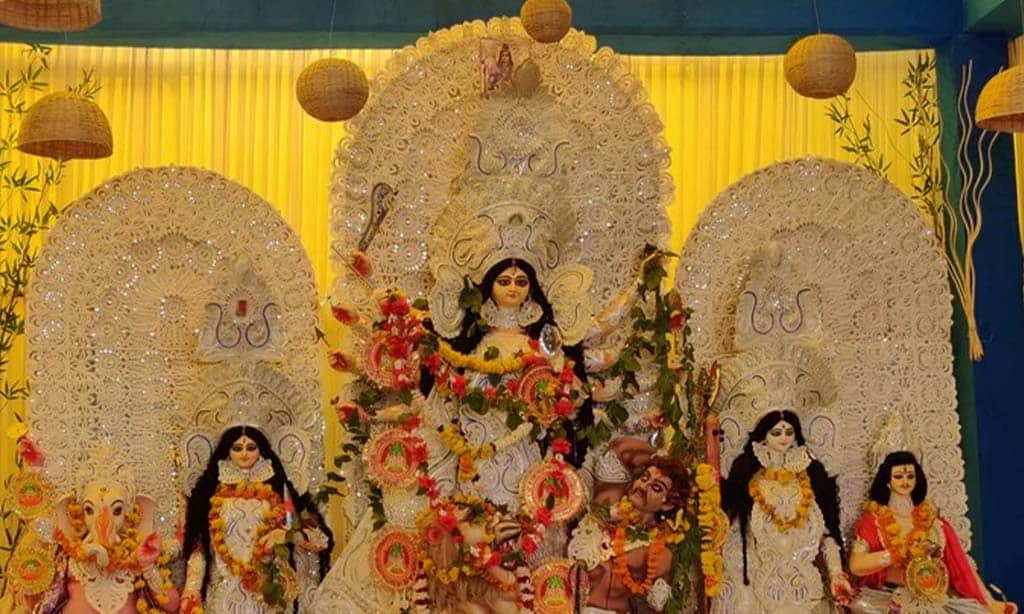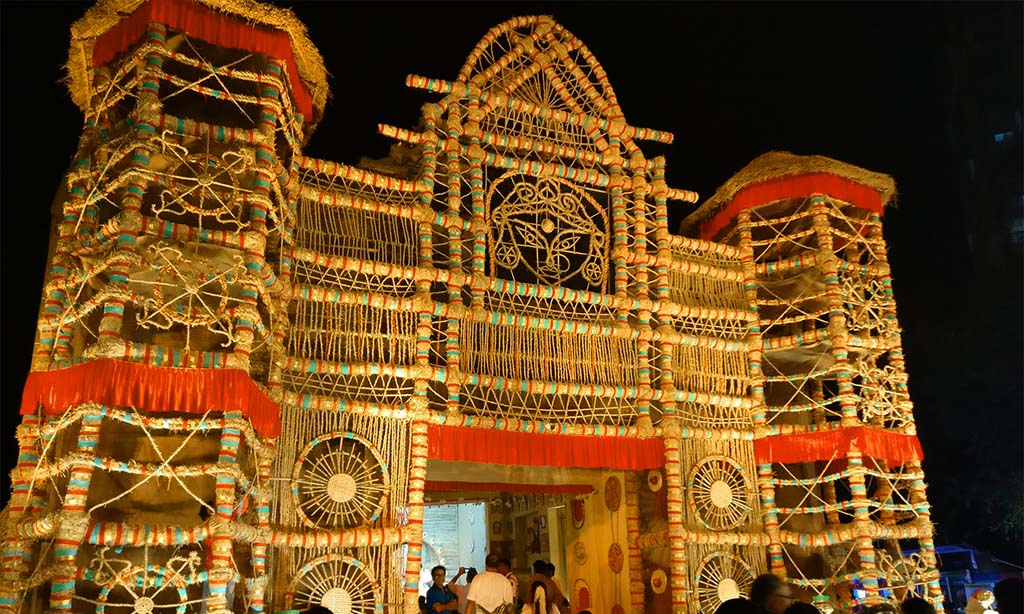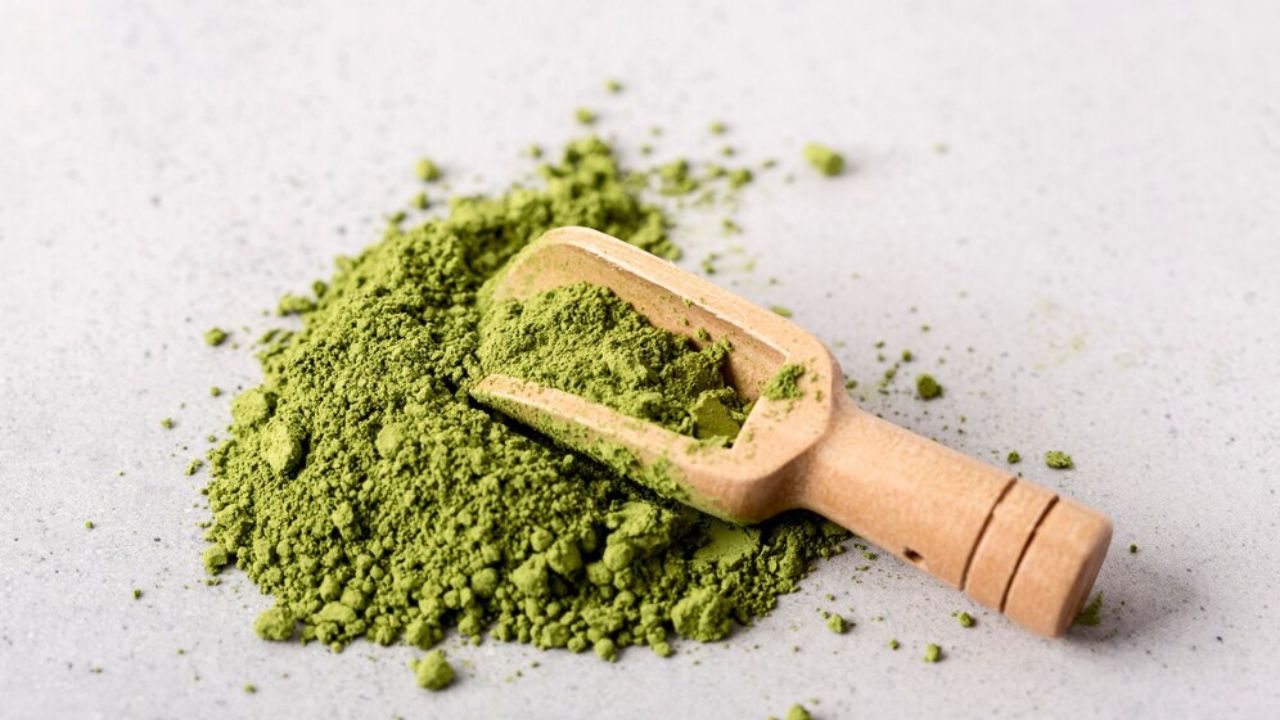Durga Puja is a celebration of the divine, filled with grand festivities, vibrant cultural programs, and communal harmony.
However, with the scale of these celebrations, the environmental impact is becoming increasingly evident.
The excessive use of plastics, chemical-laden idols, and extravagant lighting all contribute to pollution, leading to long-term damage to the environment.
In recent years, a shift toward eco-friendly practices during festivals like Durga Puja has gained momentum, as more people recognize the importance of celebrating responsibly.
By making sustainable choices, we can continue to honor the rich traditions of Durga Puja while minimizing our impact on the environment.
This detailed guide explores practical, eco-conscious steps you can take to make your Durga Puja celebrations greener, ensuring that the festival is not just joyful but also kind to the planet.
Why Celebrate Durga Puja Sustainably?
Durga Puja celebrations are grand and elaborate, involving millions of people across India and beyond.
Unfortunately, the large-scale use of non-biodegradable materials, chemical-laden paints, and single-use plastics leads to significant pollution.
Adopting sustainable practices helps:
1. Minimize Environmental Impact:
Reducing the use of harmful materials ensures that we protect our water bodies, soil, and air from long-term damage.
2. Conserve Resources:
Sustainable practices, like using energy-efficient lighting and natural materials, help conserve valuable resources like electricity and raw materials.
3. Promote Healthier Communities:
A cleaner, greener environment promotes the well-being of both people and wildlife.
4. Preserve Cultural Traditions:
Sustainable celebrations do not mean sacrificing the essence of the festival.
In fact, they enhance it by aligning with the deep spiritual respect for nature present in many of our cultural rituals.
Now, let’s explore how you can make your Durga Puja celebrations more sustainable.
1. Choose Eco-Friendly Idols: The Foundation of a Green Celebration
The Problem with Traditional Idols
One of the most critical aspects of Durga Puja is the idol immersion (visarjan), which is traditionally done in rivers or lakes.
However, idols made from Plaster of Paris (PoP), synthetic paints, and other non-biodegradable materials take months to decompose, contaminating water bodies with toxic chemicals like mercury and lead.
These harmful substances can affect aquatic life, soil quality, and even human health when they enter the water supply.
The Sustainable Choice: Clay Idols
To mitigate this, opt for natural clay idols or shadu mitti idols, which are biodegradable and dissolve quickly in water.
These idols, often adorned with natural, non-toxic paints, prevent pollution and ensure that the immersion ceremony doesn’t harm local water bodies.
By choosing these idols, you not only preserve the environment but also support local artisans who practice sustainable craftsmanship.
Additional Tips:
- Avoid idols with glitter or metallic paint, as they often contain plastic particles that can harm the environment.
- Choose idols made from recycled paper or seeds that can later grow into plants when immersed.
2. Use Sustainable Decorations: Beauty That Doesn’t Harm
The Environmental Impact of Traditional Decorations
Most pandals and homes are adorned with plastic, thermocol, and other non-biodegradable decorations that add to the growing problem of landfills.
These decorations may look festive, but they take hundreds of years to decompose, contributing to pollution long after the festival is over.
Eco-Friendly Decoration Alternatives
Decorating your pandal or home doesn’t need to come at the cost of the environment.
Opt for biodegradable materials such as jute, bamboo, paper, and cloth. These materials not only look beautiful but are also environmentally friendly and sustainable.
You can also use local flowers like marigolds and jasmine, which are both traditional and eco-conscious.
Creative Decoration Ideas:
- Use upcycled materials like old fabrics, glass jars, and tins for unique, eco-friendly decorations.
- Incorporate handcrafted items made by local artisans using sustainable materials.
- Create garlands from dried flowers and leaves that can later be composted.
3. Opt for Energy-Efficient Lighting: Brighten Your Celebrations Sustainably
The Energy Drain of Festive Lighting
One of the most striking features of Durga Puja celebrations is the dazzling lighting that adorns pandals and homes.
However, traditional incandescent bulbs consume large amounts of electricity, increasing the overall carbon footprint of the festival.
With rising energy costs and environmental concerns, it’s essential to consider energy-efficient alternatives.
Sustainable Lighting Solutions
Switch to LED lights, which use significantly less energy and last much longer than traditional bulbs.
LED lights are available in various colors and styles, making them a perfect choice for festive décor.
For an even greener option, consider using solar-powered lights, which charge during the day and shine brightly at night without consuming any electricity.
Tips for Sustainable Lighting:
- Opt for string lights that are energy-efficient and can be reused for other occasions.
- Use natural lighting such as candles or diyas (oil lamps) made of clay to reduce electricity use while maintaining a traditional feel.
- Encourage community pandals to use timed lighting systems that conserve energy by automatically turning off after a specific time.
4. Say No to Single-Use Plastics: Reduce Waste During Festivities
The Plastic Problem During Durga Puja
Single-use plastics, such as disposable cups, plates, and decorations, are widely used during festivals.
These plastics often end up in landfills or, worse, in water bodies, where they remain for centuries, polluting the environment.
The convenience of single-use plastics comes at a heavy cost to nature.
How to Avoid Plastic Waste
Replace single-use plastic items with biodegradable alternatives like areca leaf plates, bamboo cutlery, and jute bags.
These materials are compostable and cause no harm to the environment.
You can also encourage guests to bring their own reusable water bottles and cups, reducing the need for disposable items.
Suggestions:
- Use reusable or compostable tableware for serving food and drinks at pandals and homes.
- Replace plastic garlands with cloth or flower garlands that can be composted after the festival.
5. Sustainable Offerings and Rituals: Honoring the Earth Alongside the Goddess
The Environmental Impact of Traditional Offerings
Offerings like flowers, fruits, and grains are central to Durga Puja rituals.
However, after the rituals are over, these offerings are often discarded improperly, leading to unnecessary waste.
In some cases, the packaging of these offerings, especially if wrapped in plastic, adds to the environmental burden.
Make Offerings Eco-Friendly
Choose organic and locally sourced offerings to reduce the environmental impact of the festival.
Organic flowers and fruits are grown without harmful chemicals, while locally sourced items reduce the carbon footprint associated with transportation.
After the rituals, instead of throwing away flower offerings, consider composting them.
Additional Ritual Practices:
- Use cloth or paper packaging for offerings instead of plastic.
- Encourage the use of reusable utensils and plates during rituals and meals, minimizing waste.
- Ensure that any leftover food is donated or composted instead of being thrown away.
6. Promote Green Transportation: Travel with Sustainability in Mind
The Carbon Footprint of Festival Travel
During Durga Puja, many people travel long distances to visit pandals, leading to increased vehicle emissions.
This surge in traffic, coupled with the use of personal vehicles, adds to air pollution and congestion in cities.
Sustainable Travel Options
Encourage carpooling, use of public transportation, or even walking to reduce your carbon footprint.
Walking or cycling not only helps the environment but also allows you to enjoy the festive atmosphere more closely.
For longer distances, consider traveling in groups to reduce the number of vehicles on the road.
Tips for Green Travel:
- If you’re part of a community puja, organize shuttle buses for visitors to reduce the number of cars on the road.
- Promote cycling or walking as fun and eco-friendly ways to visit nearby pandals.
7. Build Eco-Friendly Pandals: Constructing with Nature in Mind
The Environmental Cost of Pandals
Pandal construction often involves using materials like thermocol, plastic, and synthetic fabrics, which contribute to waste once the festival is over.
These materials take years to decompose, adding to the growing problem of pollution.
Sustainable Pandal Design
To reduce waste, opt for eco-friendly pandal materials like bamboo, jute, wood, and cloth, which are biodegradable and reusable.
Some communities have started building recycled or modular pandals, which can be dismantled and reused in future years.
Ideas for Sustainable Pandals:
- Use natural materials like leaves, flowers, and fabric to create unique and beautiful designs.
- Consider minimalist décor, which focuses on simplicity and sustainability while maintaining a festive ambiance.
8. Minimize Noise Pollution: Celebrate in Harmony
The Problem of Noise Pollution
Loudspeakers, firecrackers, and continuous drumming can disrupt not only human communities but also wildlife.
Noise pollution during festivals is a significant environmental issue that often goes unaddressed.
Sustainable Sound Practices
Instead of using loudspeakers or blasting music, consider using traditional instruments like conch shells, bells, and drums to celebrate Durga Puja.
Encourage community pandals to set up quiet zones for reflection and meditation, creating a balance between celebration and peace.
Tips to Reduce Noise:
- Set limits on the volume and duration of amplified music at pandals.
- Encourage the use of non-amplified sound systems for cultural programs and rituals.
9. Effective Waste Management: Keeping Spaces Clean
The Growing Waste Problem During Durga Puja
Durga Puja generates a considerable amount of waste, from food wrappers and plastic cups to discarded decorations and ritual offerings.
Improper disposal of this waste often results in littering and clogged drains, causing environmental and public health problems.
Sustainable Waste Practices
Set up waste segregation systems at pandals and homes, ensuring that all waste is sorted into organic, recyclable, and non-recyclable categories.
Organic waste, such as leftover food and flower offerings, can be composted, while plastics and metals can be recycled.
Encourage festival-goers to bring their own reusable containers to reduce packaging waste.
Steps for Effective Waste Management:
- Organize clean-up drives after the festival to ensure that all public spaces and water bodies are kept clean.
- Collaborate with local waste management organizations to ensure proper disposal and recycling.
10. Spread Awareness: Making Sustainability a Community Effort
Using Durga Puja as a Platform for Education
Durga Puja is not just a religious festival but also a cultural event that brings together entire communities.
Use this opportunity to raise awareness about environmental sustainability by organizing workshops, distributing pamphlets, and encouraging conversations about eco-friendly practices.
Ways to Spread the Message:
- Share sustainable celebration tips on social media to inspire others.
- Use posters and banners at pandals to educate festival-goers about the importance of eco-conscious choices.
Conclusion: Celebrating Durga Puja in Harmony with Nature
Sustainability and celebration can go hand in hand.
By making small yet impactful changes, we can ensure that Durga Puja remains a joyous occasion for generations to come without causing harm to the environment.
From eco-friendly idols to sustainable pandal decorations and mindful waste management, every choice we make contributes to a greener, more harmonious celebration.
Let’s pledge to celebrate Durga Puja with a green heart, honoring not only the goddess Durga but also the planet that sustains us.
Together, we can make a difference—one eco-friendly celebration at a time.













































